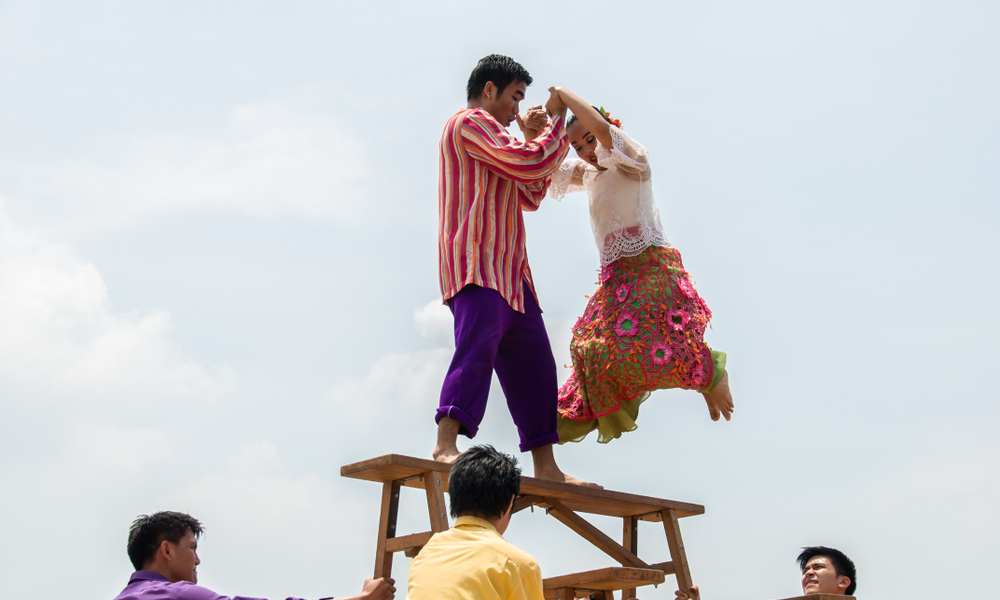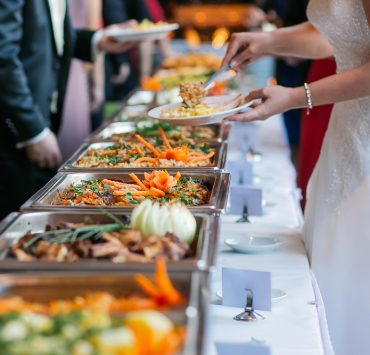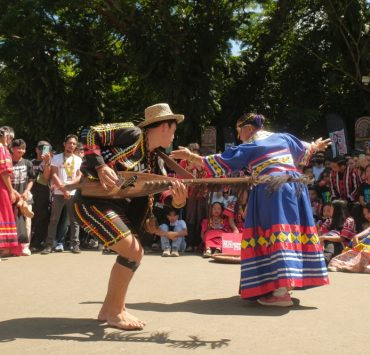Wedding folk dances in the Philippines are vibrant expressions of tradition, culture, and celebration. These lively performances join weddings with an exciting blend of movement, music, and symbolism.
Often accompanied by traditional music and costumes, these dances create an atmosphere of festivity, and bring themes of love, unity, and joy as the bride and groom embark on a new life together.
From the graceful Binasuan where dancers delicately balance glasses, to the spirited Sayaw sa Bangko with its bench-balancing acrobatics, below are some of the well-known Philippine wedding folk dances from different regions and cultures.
Philippine Wedding Folk Dances: Shaping and Enriching Wedding Culture
The father-daughter dance is a common wedding practice around the world that symbolizes the bride’s bond with her father and her family. Although this practice is also popular in the Philippines, some couples or communities also incorporate wedding folk dances as another practice that honors Filipino traditions.
Folk dances serve an important role in the preservation of culture. These deeply-rooted customs distinguish communities and are vibrant expressions of celebration, love, entertainment, and courtship.
In addition, access to ancestral dances is a priceless heritage that binds generations together at weddings. These dances connect the past to the present, conveying the stories, emotions, and values of a society.
Engaging in cultural dances is an invaluable Filipino wedding tradition that strengthens the bonds of families and infuses weddings with a rich heritage that keeps cultural customs alive.
10 Wedding Folk Dances in the Philippines
Binasuan
- Wedding folk dance from: Pangasinan
- What makes it special: “Binasuan” means “with the use of drinking glasses.” This wedding folk dance in the Philippines has been practiced for centuries as a way for people to give thanks to the gods.
Binasuan displays the ability of performers to balance a glass on their heads and on each of their hands. What makes this extra challenging is that each glass is filled with rice wine, and performers have to complete the dance without spilling a drop! - How it’s performed: Before beginning the dance, performers fill three glasses halfway with rice wine (water can also be used). One glass is balanced on the flattest part of the head, and the remaining glasses are placed on each outstretched palm.
Dancers perform a series of intricate and coordinated movements while ensuring that they do not spill the drinks. These movements may include twirls and spins similar to a waltz.
Habanera Botolena
- Wedding folk dance from: Botolan, Zambales
- What makes it special: This wedding folk dance in the Philippines has strong influences from Spanish flamenco dances. It’s a popular dance at weddings and other celebrations such as baptisms and fiestas. Performers of the Habanera Botolena at weddings involve not only the bride and groom, but their parents, bridesmaids, and groomsmen as well.
- How it’s performed: The Habanera step involves taking a step, closing the feet together, and then taking another step. The dance includes fast footwork, jumps, and glides. Dancers usually keep their arms outstretched and maintain graceful hand positions to show love and happiness towards their partner.
Igal
- Wedding folk dance from: Tabawan, Tawi-Tawi
- What makes it special: Igal is practiced among the Sama-Tabawan of the island of Tabawan. Performed at Filipino Muslim weddings, the Igal is danced by the relatives of the bride and groom during a full moon.
- How it’s performed: As the full moon rises, family members engage in the dance characterized by rapid footsteps, shoulder shrugging, and arm swaying, all harmonizing with the rhythmic sounds of the tagunggu’an ensemble. This segment of the wedding is intimate since it’s exclusively viewed by the bride and groom’s relatives and invited friends.
Kandingan
- Wedding folk dance from: Jolo, Sulu
- What makes it special: Another Muslim tradition, Kandingan has influences from Indian dance forms. The name of the dance is derived from gandang, a type of drum covered in goatskin at both ends.
- How it’s performed: Dancers execute the performance with a slight outward bend in their knees and their fingers held rigidly together. There is actually no set number of steps nor prescribed foot and arm movements. Instead, the dance relies entirely on the individual dancer’s skill and current mood.
Kuratsa
- Wedding folk dance from: Samar Island
- What makes it special: Often performed at weddings, this folk dance was also used as a traditional courtship practice that imitates a rooster’s mating movements with a hen. The performance of Kuratsa varies between different provinces and can also be performed during other celebrations, such as fiestas.
- How it’s performed: The Kuratsa is danced in pairs—one male, one female. The dance is divided into three parts to symbolize the playful courtship between a man and a woman. The first part is a waltz, followed by the male dancer pursuing the female in a chase. The final part shows the male dancer succeeding in winning over the female through his dancing.
La Jota Moncadeña
- Wedding folk dance from: Moncada, Tarlac
- What makes it special: La Jota Moncadeña was based on a Spanish courtship dance and features traditional Spanish music. In Tarlac, the dance is known by another name: Jota Florana.
- How it’s performed: La Jota Moncadeña is performed using an Ilocano instrument called the tallelet. Dancers perform a waltz, with the female dancers holding their skirts and the male dancers placing their hands on their waists.
Although it’s a folk dance for weddings, La Jota Moncadeña can also be performed at festivals and funeral processions.
Pangalay
- Wedding folk dance from: Tausug
- What makes it special: “Pangalay” means “temple of dance” in Sanskrit. The dance resembles classical Balinese and Thai dances and is commonly known as the fingernail dance. Pangalay is usually performed during festive celebrations and emphasizes the upper-body agility of the dancers.
- How it’s performed: The dancers use intricate body movements and gestures while wearing metal claws called janggay. This Philippine wedding folk dance can also be performed by a couple atop bamboo poles carried by four men. Pangalay is believed to imitate the movements of birds and fish from Tausug communities.
Pantomina
- Wedding folk dance from: Bicol
- What makes it special: “Pantomina” comes from the Spanish word for “pantomime” and was based on the courting movements of doves. It was formerly known as “Salampati,” which is Bicol’s term for doves. Performing the Pantomina is a way for the couple to show their love to their family through a folk dance at their wedding.
- How it’s performed: While dancers may improvise their steps, the dance generally mimics the movement of flying doves.
During a Pantomina, it’s also customary for wedding guests to either toss coins or lay cash on a plate positioned on the floor. This makes the Pantomina a form of the traditional Filipino money dance.
Sayaw sa Bangko
- Wedding folk dance from: Pangasinan
- What makes it special: Sayaw sa Bangko is a Philippine wedding folk dance literally translated as “dance on top of a bench.” The bench used is quite narrow—typically only six inches! It’s important that the dancers work well together since they will be relying on each other for support and balance as they both move around the slim bench.
- How it’s performed: Despite the limited space, the Sayaw sa Bangko can involve jumping, hopping, and spinning. The couple gradually moves and hops from one side of the bench to the other. The dancers can further exhibit their skill by lifting the female dancer into the air while the male dancer skillfully maneuvers around the bench.
Tayaw
- Wedding folk dance from: Igorot
- What makes it special: Tayaw means “fly” among Igorots, and is used as an expression of thanksgiving or celebration. Aside from being a wedding folk dance in the Philippines, the Tayaw symbolizes unity and power to face threats against a community.
- How it’s performed: A male and a female dancer each perform distinct segments to the beat of the gong. The man’s dance involves draping blankets over his shoulders, while the woman dances with a sarong.The arm movements during the Tayaw dance also have specific meanings. For example, spreading one’s arms stands for independence and freedom, while closing one’s fingers together stands for unity. Facing the palms downwards means giving respect to departed ancestors, although this dance is never performed during a wake.
Keep Heritage Alive Through Filipino Wedding Folk Dances
This is just a glimpse of the vibrant wedding folk dances that enrich Philippine culture. These dances go beyond mere performances; they serve as a bridge between generations and are a testament to the enduring love and traditions of Filipino families.
Through the spirited movements and rhythms of these dances, we not only honor our past but also create memories for the future. So, as you plan your wedding, consider embracing the timeless beauty and cultural significance of these dances, and make your wedding even more memorable for generations to come!
Continue browsing Nuptials.ph for more stories and guides on traditional wedding practices in the Philippines.
Author: Anjenica Durana
Anjenica's biggest dream in life is to go on a great adventure. While still waiting for a tall wizard to knock at her door, or for a fairy to fly through her window, or for her grandmother to reveal their royal lineage (any time now), she works undercover as a writer who pretends to enjoy playing badminton.



